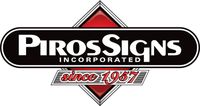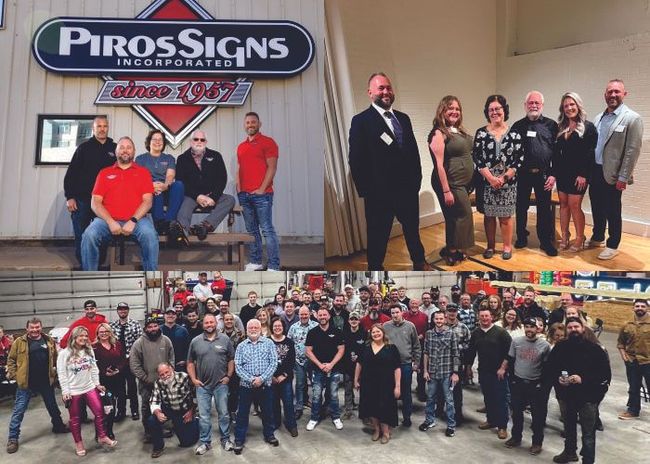In today’s competitive marketplace, visibility is everything. Large-scale outdoor signage plays a powerful role in helping businesses stand out, attract foot traffic, and reinforce brand recognition. Whether you run a gas station off the highway or a corporate office in a bustling downtown, the right signage can be a beacon for potential customers.
In this guide, we’ll explore three of the most effective outdoor sign types: pylon signs, hi-rise signage, and monument signs. Each offers unique advantages depending on your location, audience, and branding needs.
Why Outdoor Signage Matters for Business Visibility
The Role of Outdoor Signs in Brand Awareness
Outdoor signage is your first impression, an ever-present advertisement that speaks for your brand 24/7. Whether it’s directing customers, reinforcing your identity, or standing tall above your competitors, a well-placed sign can transform your business visibility.
Take the case of a gas station that replaced its small roadside sign with a towering pylon structure. The result? A 40% increase in drive-by traffic. That’s the power of scale and strategic placement.
The Psychology of Outdoor Signage: What Makes a Sign Stand Out?
Great signage is a mix of science and art. Here are key psychological and design elements:
- Color Contrast & Brightness: High-contrast colors improve legibility; illuminated signs increase visibility at night.
- Font & Spacing: Use bold, sans-serif fonts with ample spacing.
- Location: Choose areas near major roads, intersections, or high-footfall zones.
- Height & Size: Bigger signs with higher placement are more readable from a distance.
- Lighting: LED-lit signs outperform static signs for nighttime visibility.
- Design Consistency: Your sign should reflect your brand identity with logos, colors, and fonts.
Understanding Pylon Signs and Their Benefits
What Are Pylon Signs?
Pylon signs are tall, freestanding signs mounted on one or more poles. Typically found near roadways or at shopping centers, they provide high visibility for businesses looking to grab attention from drivers or distant pedestrians.
Best For:
- Shopping plazas
- Gas stations
- Fast food restaurants
- Hotels and motels
- Business parks
How Pylon Signs Enhance Business Visibility
The biggest advantage? Height. A pylon sign can rise above visual clutter and reach people driving by at 40+ mph. Many businesses opt for multi-tenant pylon signs, allowing multiple brands to share visibility at a single location.
Example: A strip mall in St. Louis installed a modern pylon sign with LED panels. The result? A 50% increase in visibility for smaller tenants.
Challenges & Considerations
- Higher upfront cost due to size and materials
- Regular maintenance for lighting and structural integrity
- Zoning limitations on height and brightness
Real-World Example
A regional shopping center in Kansas City reported a 35% increase in traffic after replacing a dated monument sign with a sleek, illuminated pylon structure.
Illuminated vs. Non-Illuminated Pylon Signs
| Feature | Illuminated Pylon Sign | Non-Illuminated Pylon Sign |
| Night Visibility | Excellent | Limited |
| Energy Usage | Higher (LEDs preferred) | None |
| Cost Over 5 Years | $25,000-$100,000 | $10,000-$50,000 |
| Maintenance | Moderate (bulbs, panels) | Low |
Hi-Rise Signs: Elevating Your Brand to New Heights
What Are Hi-Rise Signs?
Hi-rise signs are the giants of the signage world, typically exceeding 50 feet in height and can coar up to 199 feet or more depending on local zoning regulations. Designed to be seen from long distances, especially along highways and interstates, these towering signs serve as navigational beacons and powerful branding tools.
Constructed with durable materials and often illuminated for 24/7 visibility, hi-rise signs are engineered to withstand the elements while broadcasting a business’s presence to thousands of potential customers daily.
Best For:
- Gas stations: Help travelers locate fuel stops well before an exit.
- Hotels: Signal convenient lodging for highway drivers and out-of-town visitors.
- Large retailers: Boost brand visibility in big-box store complexes or shopping centers.
- Stadiums: Create recognizable landmarks that aid in wayfinding.
- Corporate headquarters: Make a bold statement and establish brand dominance.
The Strategic Advantages of Hi-Rise Signage
- Highway Visibility: Hi-rise signs are specifically designed to cut through the visual noise of busy highways and catch the attention of fast-moving traffic. Positioned near major exits or interchanges, they provide early notice of services like gas, food, or lodging.
- Brand Authority: Nothing says “we’re established” like a towering, professionally designed sign. Hi-rise signage communicates scale, success, and permanence, making it ideal for brands that want to appear dominant or top-of-mind.
- Traveler Attraction: For businesses catering to travelers, think fast-food chains, gas stations, or convenience stores, hi-rise signs act as visual cues that tap into immediate needs. A visible sign from a mile away can give drivers time to decide and safely exit, increasing the likelihood of impulse visits.
Example: Chains like McDonald’s and Burger King use hi-rise signage to create landmarks on highways, ensuring travelers never miss their exits.
Permitting & Regulations for Hi-Rise Signs
With great height comes great responsibility and strict regulations. Due to their size, structural complexity, and potential community impact, hi-rise signs are often subject to detailed permitting requirements. Here’s what business owners should consider:
- Height Restrictions: Municipalities typically set limits on how tall signs can be, often capping height at 35 to 100 feet, depending on the zoning district. Urban areas may have more restrictive height allowances, while highway commercial zones offer more flexibility.
- Wind Load Engineering: Because of their size, hi-rise signs must be engineered to withstand extreme wind conditions and seismic loads, particularly in regions prone to storms or earthquakes. Structural integrity is a safety and legal issue. This involves using heavy-duty foundations, steel framing, and specialized mounting hardware.
- Illumination Limits: Cities may limit the brightness or hours of operation for illuminated signage to reduce light pollution and protect neighboring properties. Some jurisdictions require light shielding or automatic dimmers for LED signs after certain hours.
Monument Signs: Elegant, Ground-Level Visibility for Local Branding
What Are Monument Signs?
Monument signs are low-to-the-ground, architectural signs placed at the entrance of a building or complex. Built from materials like brick, stone, or metal, they often mirror the building’s aesthetic.
Best For:
- Corporate offices
- Schools and universities
- Medical centers
- Neighborhood entrances
- Luxury properties
Advantages of Monument Signs
- Refined Look: Adds prestige to upscale locations
- Durability: Withstands weather and wear
- Brand Identity: Ideal for local businesses seeking brand reinforcement
Challenges & Considerations
- Lower visibility than elevated signage
- Zoning limits on dimensions and materials
- Premium costs for materials like stone or brushed metal
Best Uses for Monument Signs
Perfect for businesses that value aesthetic appeal and local foot traffic over mass-market visibility.
Real-World Example
A law firm in Nashville installed a custom monument sign using stone and bronze finishes. Result: an increase in walk-in clients and greater credibility in the community.
How to Choose the Right Outdoor Sign for Your Businss
Key Factors to Consider
- Location: Is your business on a highway or in a neighborhood?
- Budget: Monument signs are affordable; hi-rise signs cost more.
- Brand Style: Choose modern materials for tech brands, classic for law firms.
- Permits: Always check city restrictions before installing.
Comparing Cost & ROI
| Sign Type | Average Cost | Best For | ROI Impact |
| Pylon Signs | $10,000-$100,000 | Multi-tenant centers, busy roads | High visibility, shared marketing |
| Hi-Rise | $50,000-$500,000 | Corporate HQs, highways | Brand dominance, long-range visibility |
| Monument | $5,000-$30,000 | Neighborhoods, upscale properties | Professional appearance, local branding |
Installation & Maintenance of Outdoor Signs
Professional Installation vs. DIY: What You Need to Know
Large outdoor signs should always be installed by professionals. Mistakes can reduce visibility or even lead to fines.
- DIY Pitfalls: Poor anchoring, visibility issues, code violations
- Professional Advantage: Site analysis, structural support, code compliance
Maintenance Tips for Maximizing Sign Longevity
- LED Signs: Replace bulbs regularly, update software
- All Signs: Clean quarterly, inspect annually for structural issues
Common Mistakes to Avoid When Investing in Outdoor Signage
Choosing the Wrong Size or Placement
Too small? You won’t be seen. Too big? You might violate zoning laws. Always balance visibility with compliance.
Example: A retail store placed a sign too far back from the road, foot traffic dropped 20% until it was repositioned.
Ignoring Local Signage Regulations
Each city has unique rules on sign height, illumination, and placement. Skipping permits can result in costly removals.
Overcomplicating the Design
Less is more. Avoid cluttered text, low-contrast color schemes, or overly decorative fonts.
Example: A busy sign with five different fonts was redesigned with bold text and a cleaner layout, leading to a 30% increase in visibility.
FAQ Section
Q1: How tall should my business sign be for maximum visibility?
A: Pylon signs are usually 20–50 feet tall. Hi-rise signs can exceed 100 feet, depending on zoning laws.
Q2: Are LED signs better than traditional outdoor signs?
A: Yes. LED signs offer better night visibility, flexible messaging, and long-term energy savings.
Q3: Do pylon signs require special permits?
A: Yes. Most cities require permits for height, lighting, and structural safety.
Q4: Which type of sign is best for small businesses?
A: Monument signs are ideal for local visibility, while pylon signs attract more traffic in busy areas.
Q5: What type of business benefits most from hi-rise signage?
A: Businesses near highways—such as gas stations, hotels, and quick-service restaurants—gain the most from hi-rise signs.
Conclusion: Which Outdoor Sign Is Right for You?
Choosing the right sign comes down to visibility, branding, and budget. Pylon signs offer towering visibility for high-traffic areas. Hi-rise signs elevate your brand presence from miles away. Monument signs offer timeless professionalism for local businesses.
Each option can drastically improve your business’s foot traffic, credibility, and customer recognition.

